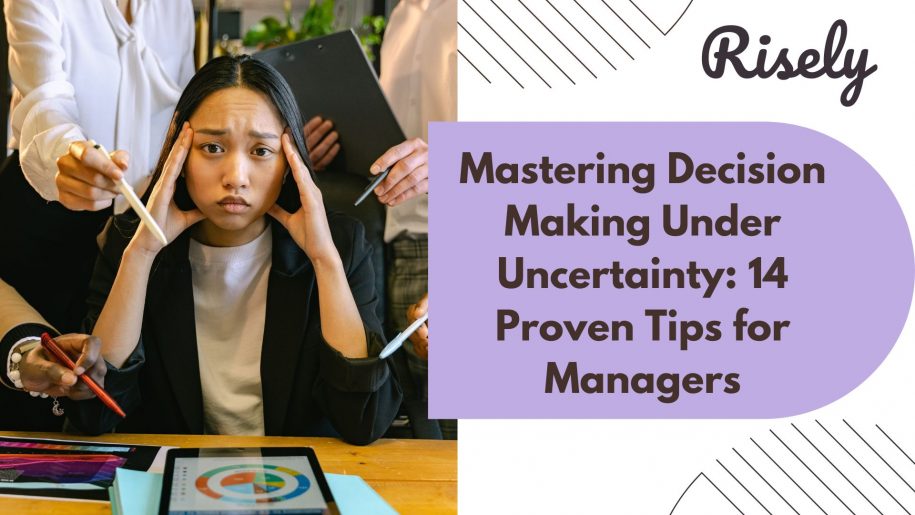Mastering Decision Making Under Uncertainty: 14 Proven Tips for Managers
Welcome to our blog on decision making under uncertainty and risk! In today’s rapidly changing world, organizations often face complex and unpredictable situations that require quick and effective decision making. However, uncertainty in decision making and risk can profoundly impact the decision-making process, leading to stress and anxiety for managers. In this blog, we explore the challenges of decision making under uncertainty and high-risk circumstances and provide practical strategies for making informed decisions. From scenario planning and prototyping to risk management and collaboration, we will provide examples and insights to help you navigate decision making under uncertainty and risk. Read here all about why decision making is important for managers?What are the risks in decision making?
In the context of decision making in the workplace, “risks” refers to the potential negative consequences or uncertainties associated with a particular decision or action. This can encompass a range of possible outcomes, including financial losses, decreased productivity, harm to reputation or brand image, or negative impacts on stakeholders such as employees or customers. When evaluating potential risks, decision makers must consider the likelihood of these outcomes occurring, as well as the potential magnitude of their impact. Understanding and managing risks is an essential aspect of effective decision making in the workplace, as it allows individuals and organizations to weigh the benefits and drawbacks of different options and make informed choices that minimize harm and maximize benefits.How does uncertainty affect decision making?
Uncertainty can significantly impact decision-making by making it more challenging to determine the best course of action. When there is uncertainty in decision making, decision makers face limited or incomplete information and must use various techniques and strategies to make decisions despite these limitations. This can lead to increased anxiety and stress, as the decision maker may feel pressure to make the “right” decision. The following are some points explaining how uncertainty in decision making gets affected:- Increased risk aversion: When faced with uncertainty, decision makers may become more risk averse and choose safer, less innovative options with fewer risks.
- Difficulty in weighing options: Uncertainty can make it more difficult to weigh the pros and cons of different options, as it can be hard to predict the outcomes of other choices.
- Incomplete information: When information is limited or unavailable, decision makers may have to make decisions based on incomplete data or assumptions, resulting in less informed choices.
- Increased complexity: Uncertainty can increase the complexity of decision making, as decision makers may have to consider a broader range of factors and potential outcomes.
- Inability to make a decision: In some cases, uncertainty can lead to indecision, as decision makers may struggle to determine the best course of action or may become paralyzed by the fear of making the wrong choice.
Difference between decision making under uncertainty and certainty?
Decision making under certainty refers to a situation where a manager clearly understands all the relevant information and the potential outcomes of a decision. In these situations, the manager has high confidence in their predictions and can make decisions with a relatively low degree of risk. For example, suppose a manager knows that a specific marketing strategy has been successful and is confident it will work again. In that case, they may implement the same strategy with high certainty. In contrast, making decision under uncertainty refers to a situation where a manager does not have complete information or cannot predict a decision’s potential outcomes with certainty. Instead, the manager may rely on assumptions, gut feelings, or limited information to make decisions. For example, suppose a manager is considering launching a new product in a new market. In that case, they may face uncertainty about the potential demand for the product and the competition, making it difficult to decide with certainty. The differences between making decision under uncertainty and certainty can lead to different results. For example, when managers can make decisions with certainty, they can act quickly and confidently, which may lead to better outcomes and improved performance. On the other hand, when a manager is faced with uncertainty, they may take more time to make decisions. As a result, they may be more cautious in their approach, reducing the risk of failure and increasing the risk of missed opportunities. In conclusion, the critical difference between decision making under uncertainty and certainty is the level of information and confidence a manager has about the potential outcomes of a decision. Understanding the difference and choosing the right approach for each situation is crucial for making effective decisions and achieving success in a constantly changing environment.Decision making under stress
Decision making under stress can be challenging, as stress can impair cognitive function and lead to impulsive or irrational decisions. However, there are several strategies managers can use to manage stress effectively and make informed decisions in high-pressure situations. These include:- Prioritizing self-care: Managers should prioritize their well-being and engage in self-care activities, such as exercise, sleep, and relaxation, to manage stress and maintain their ability to think clearly.
- Gathering information: Managers should gather as much information as possible to help inform their decision making. This can include researching, seeking input from experts or stakeholders, and using data to support their choices.
- Seeking advice: Managers can benefit from seeking the advice of trusted colleagues or mentors to gain a different perspective and help inform their decisions.
- Taking breaks: When under stress, it can be helpful to take breaks to clear the mind and refocus. This can include taking a walk, engaging in mindfulness practices, or simply stepping away from decision-making for a short period.
- Using decision-making frameworks: Managers can use structured decision-making frameworks, such as decision trees or cost-benefit analysis, to break down complex decisions into smaller, manageable components.
- Considering long-term impacts: It can be easy to make impulsive decisions in high-pressure situations. However, managers should take a step back and consider the long-term effects of their choices to ensure they align with the goals and values of the organization.
- Managing time: Effective time management can help reduce stress and make decisions on time. This can include setting priorities, delegating tasks, and avoiding procrastination.
OtherInterestingReads
Decision making under deep uncertainty
Decision making under uncertainty, where the future is highly unpredictable, and there is limited information available, can be particularly challenging for managers. However, several approaches can help managers make informed decisions in these situations:- Scenario planning: This approach involves creating multiple scenarios to explore different possible future outcomes and consider the implications of each scenario for the organization.
- Prototyping and experimentation: In situations of deep uncertainty, it can be helpful to test potential solutions through prototyping and experimentation. This allows managers to test ideas and gather data to inform future decisions.
- Flexibility and agility: When faced with decision making under uncertainty, managers should aim to be flexible and agile in their decision making, as the situation may change rapidly and require a different course of action.
- Collaboration: Collaborating with others, such as colleagues, experts, or stakeholders, can help managers gather a broader range of perspectives and knowledge to make informed decisions.
- Focus on objectives: When faced with deep uncertainty, managers must focus clearly on their organization’s objectives and goals. This helps ensure that decisions align with the overall strategy of the organization.
- Risk management: Managers should also consider potential risks and implement risk management strategies to mitigate adverse outcomes.
- Embrace uncertainty: Finally, managers should embrace uncertainty as a natural part of decision-making and strive to be comfortable with the unknown. This can help to reduce stress and increase confidence in decision making.
Decision making under uncertainty examples
Here are a few examples of decision making under uncertainty:- Hiring a new employee: When a manager is faced with the task of hiring a new employee, there may be uncertainty about the individual’s fit with the company culture, their ability to perform the job, and how they will interact with the rest of the team. In this scenario, the manager may use a combination of interviews, reference checks, and personality tests to gather information and make an informed decision.
- Launching a new product: A manager may have to do decision making under uncertainty when launching a new product. For example, they may be unsure about the product’s potential market demand, competition, or production feasibility. In this scenario, the manager may use market research, focus groups, and product testing to gather information and decide whether to proceed with the launch.
- Strategic planning: When making strategic decisions, a manager may be faced with uncertainty about the future of the market, the competition, or the organization’s resources and capabilities. In this scenario, the manager may use scenario planning and forecasting techniques to consider a range of potential future outcomes and make informed decisions about the organization’s strategy.
- Mergers and acquisitions: A manager may face uncertainty when considering a merger or acquisition. For example, they may be unsure about the compatibility of the two organizations, the impact on employees, or the potential for success. In this scenario, the manager may use due diligence, financial analysis, and market research to gather information and decide whether to proceed with the merger or acquisition.
- Investing in new technology: A manager may be uncertain when investing in new technology for the organization. For example, they may be unsure about the technology’s potential impact on the organization, the ROI, or the feasibility of implementation. In this scenario, the manager may use market research, cost-benefit analysis, and expert consultations to gather information and decide whether to proceed with the investment.
Conclusion
In conclusion, decision making under uncertainty and risk is a complex and challenging process, but by utilizing the right strategies and techniques, managers can make informed and confident decisions. Whether it’s through scenario planning, prototyping, experimentation, risk management, or collaboration, a range of approaches can help managers navigate uncertainty and risk in their decision making. Furthermore, by embracing uncertainty as a natural part of the process and maintaining a clear focus on objectives, managers can become effective in decision making under uncertainty. We hope this blog has provided valuable insights and practical tips to help you in decision making under uncertainty and high-risk circumstances. Thank you for reading!Attention Managers!
How well do you make decisions at work?
Dig up insights on your decision-making skills with the free assessment for managers now!
Other Related Blogs
10 Signs You’re Struggling with Analysis Paralysis at Work
10 Signs You’re Struggling with Analysis Paralysis at Work The smart fox declares, “I have a hundred ways to escape when trouble approaches. You have only one.” As the dogs…
Evidence Based Decision Making: 4 Proven Hacks For Managers
Evidence Based Decision Making: 4 Proven Hacks For Managers In this blog, we will explore the concept of evidence-based decision-making and provide seven proven hacks for managers to implement evidence-based…
6 Best Books On Decision Making For Managers
6 Best Books On Decision Making For Managers Effective decision-making is crucial for managers to navigate the complexities of their roles. You are responsible for making important choices that can…
Best Decision Coaches To Guide You Toward Great Choices
Best Decision Coaches To Guide You Toward Great Choices Effective decision-making is more crucial than ever in today’s rapidly evolving business landscape. Entrepreneurs, leaders, and professionals alike are constantly faced…


